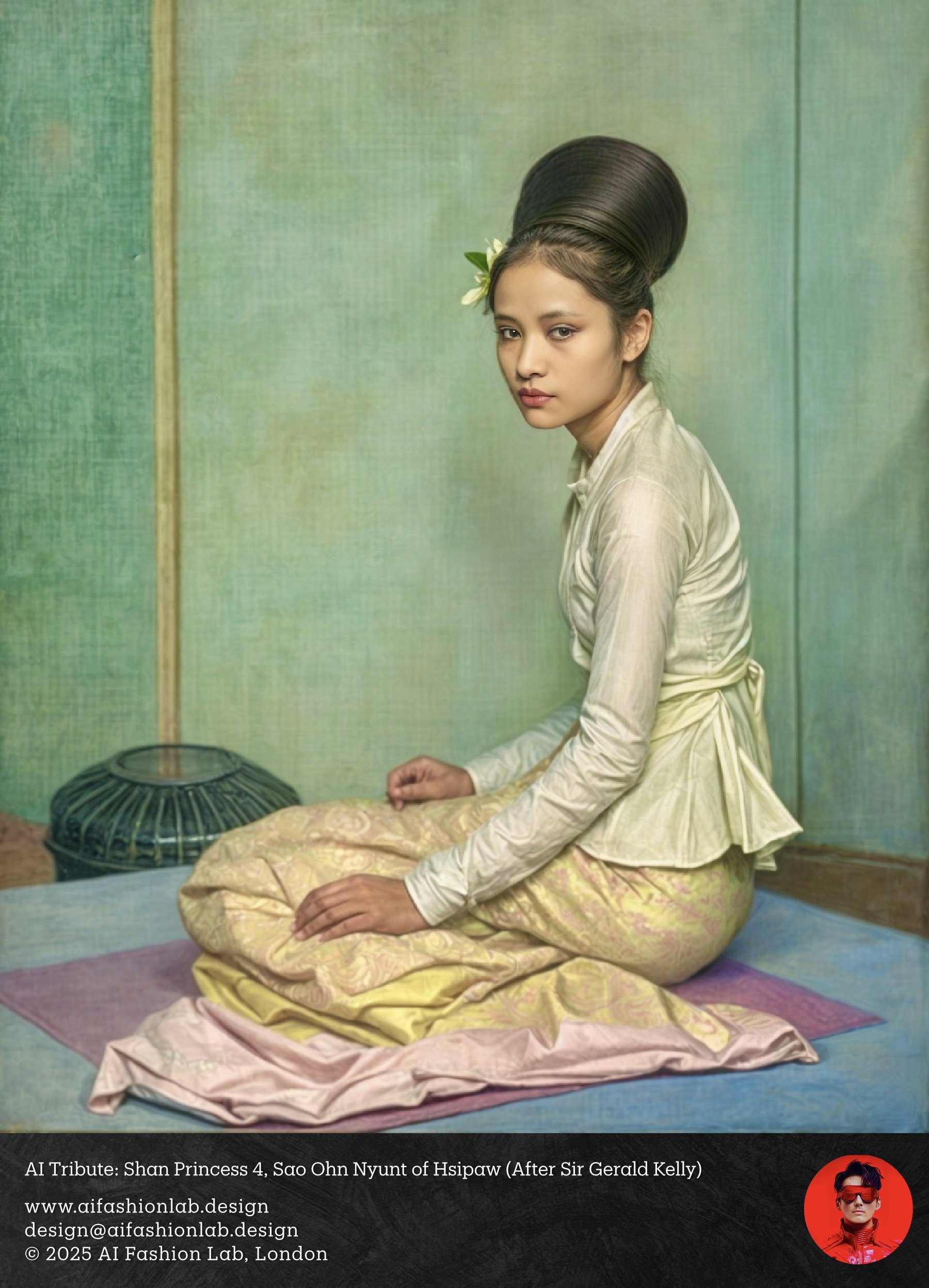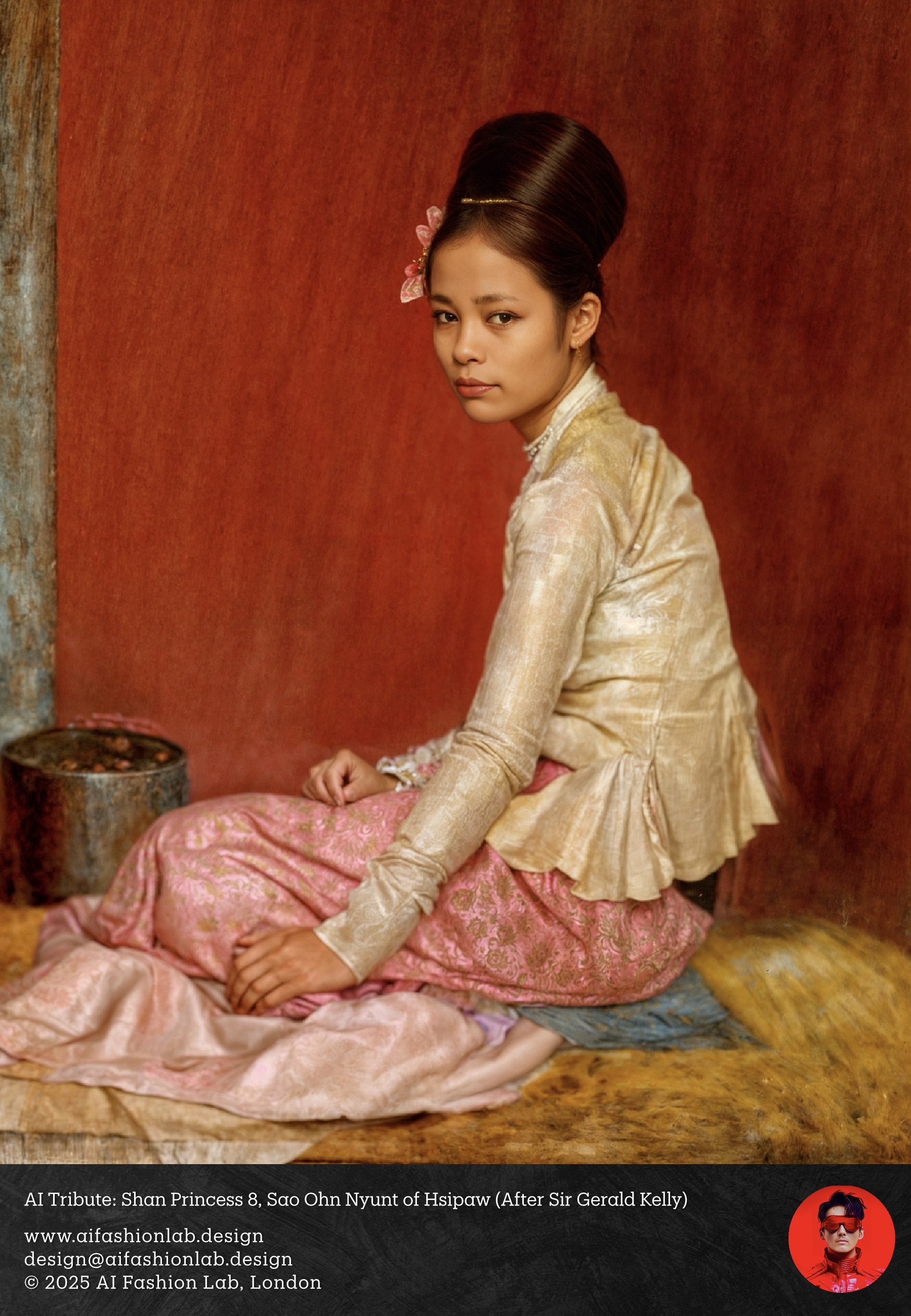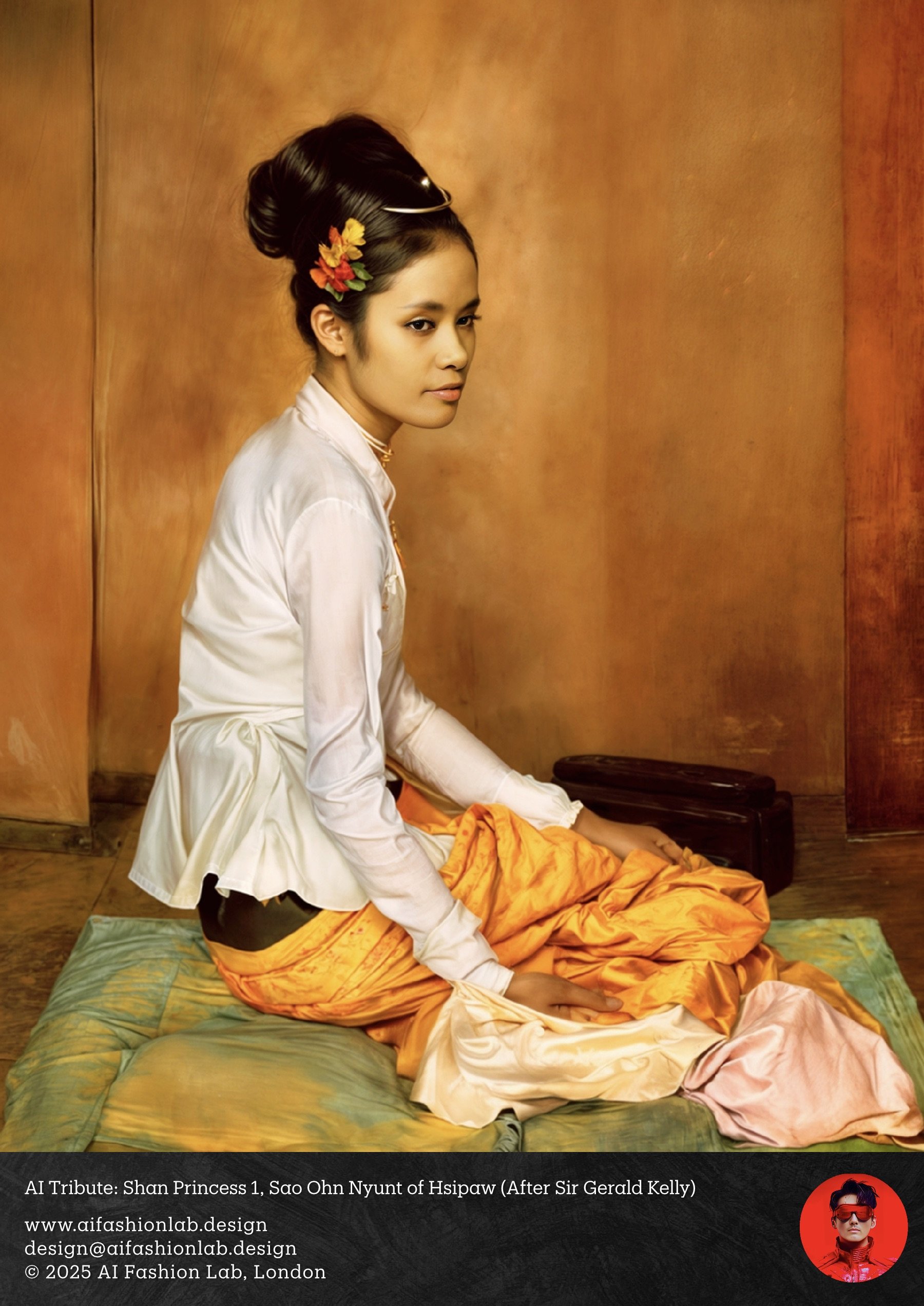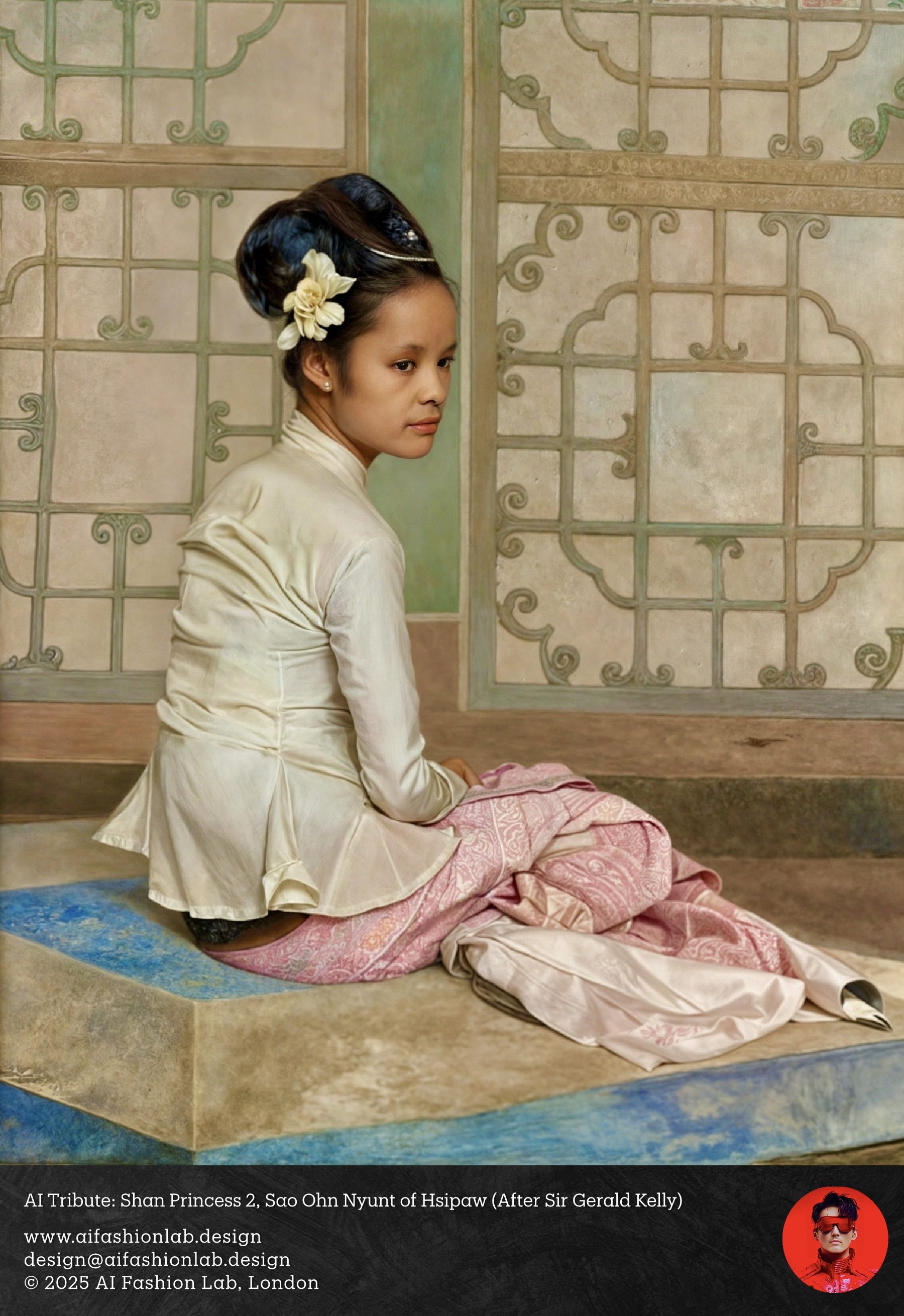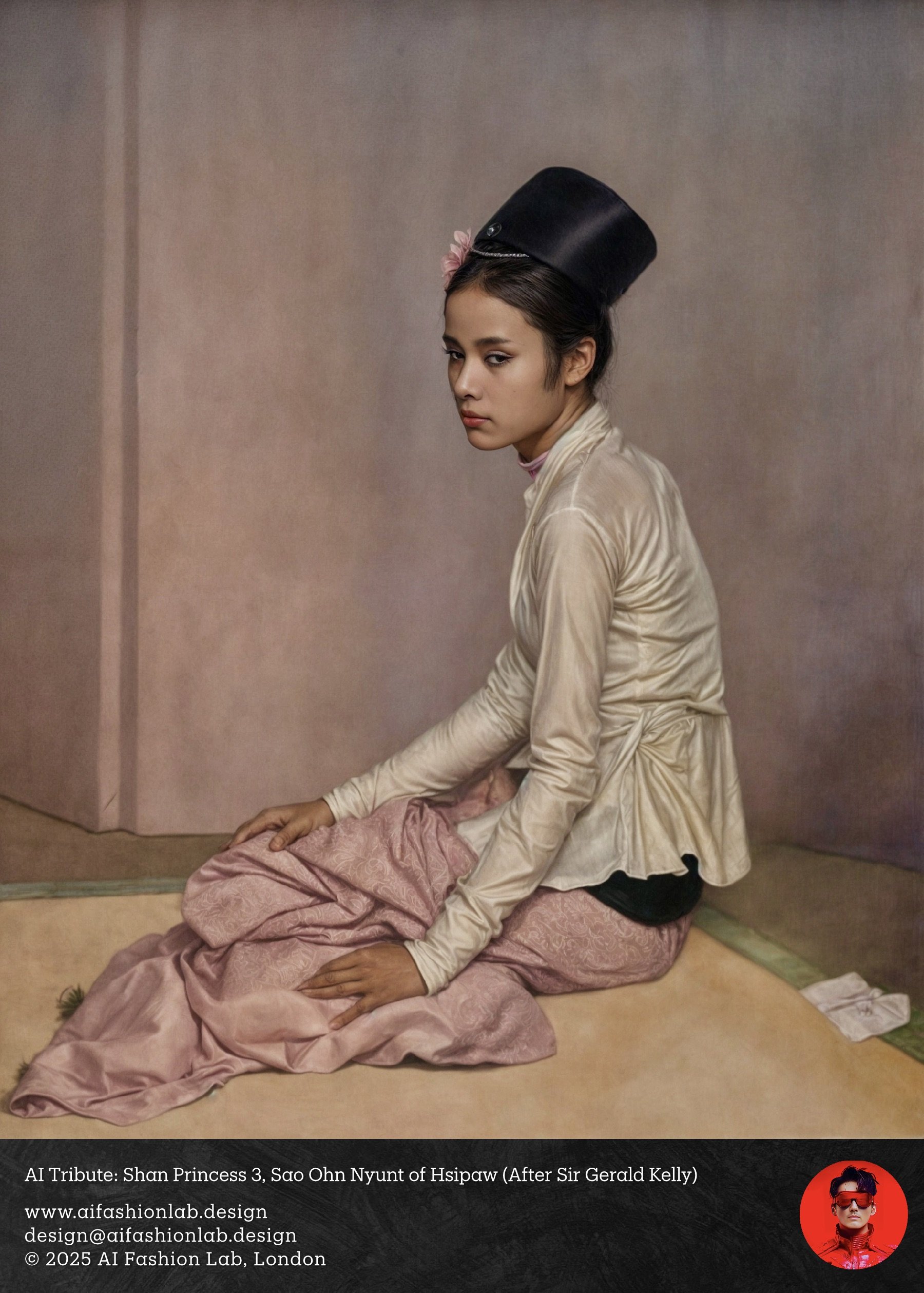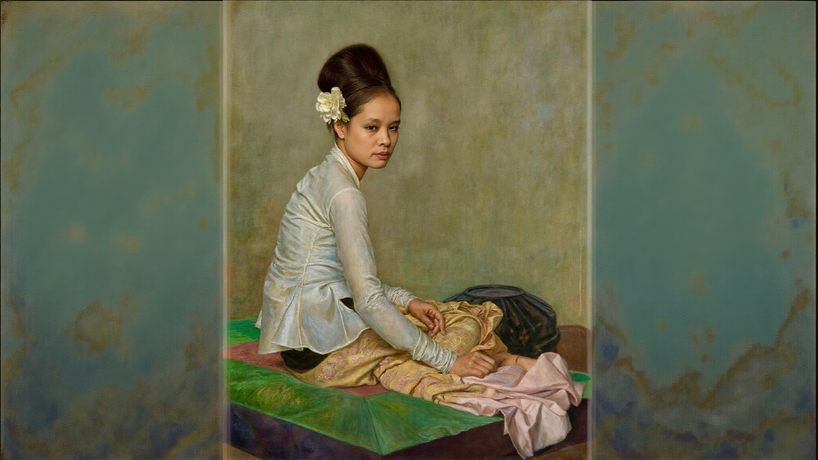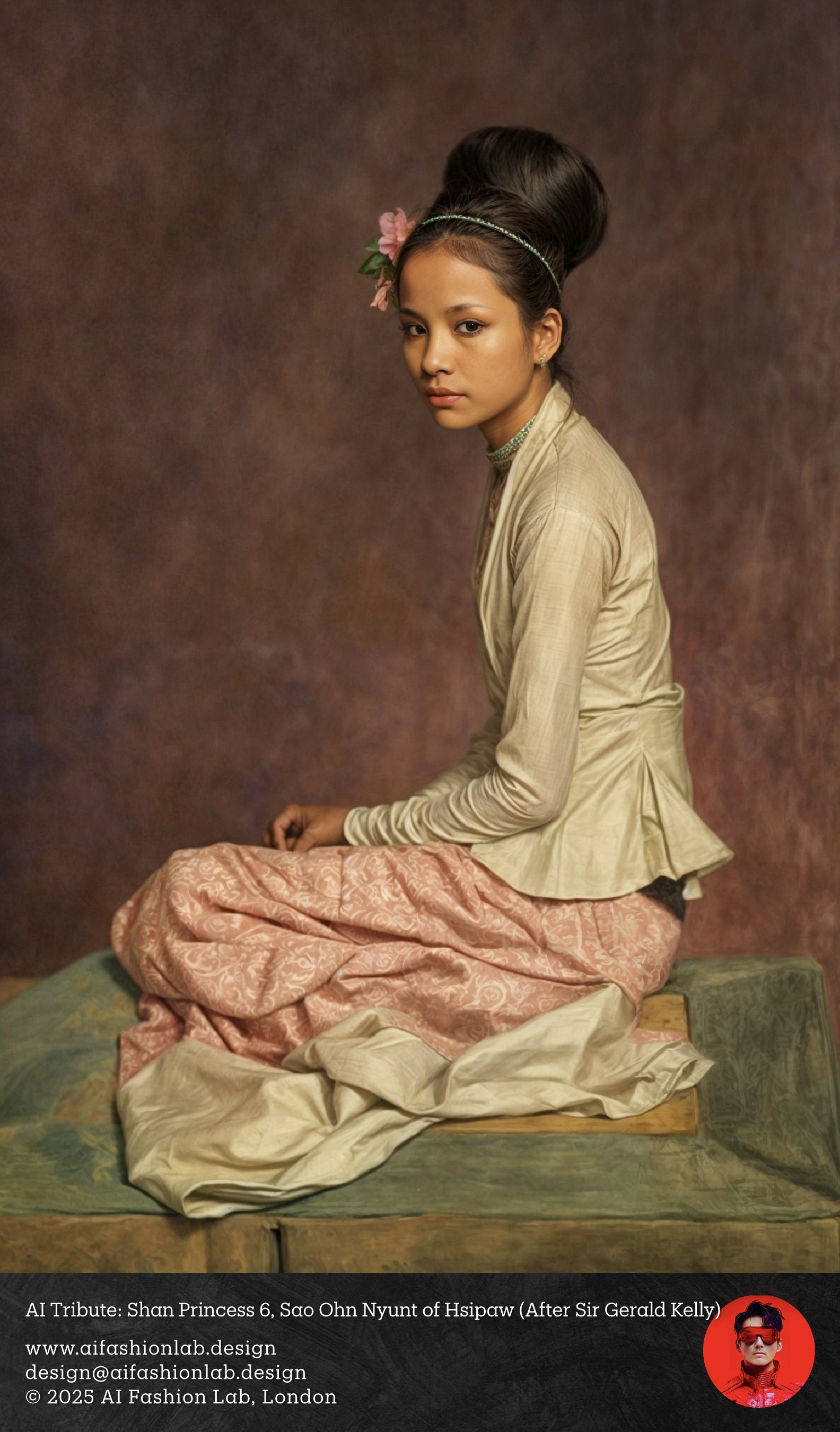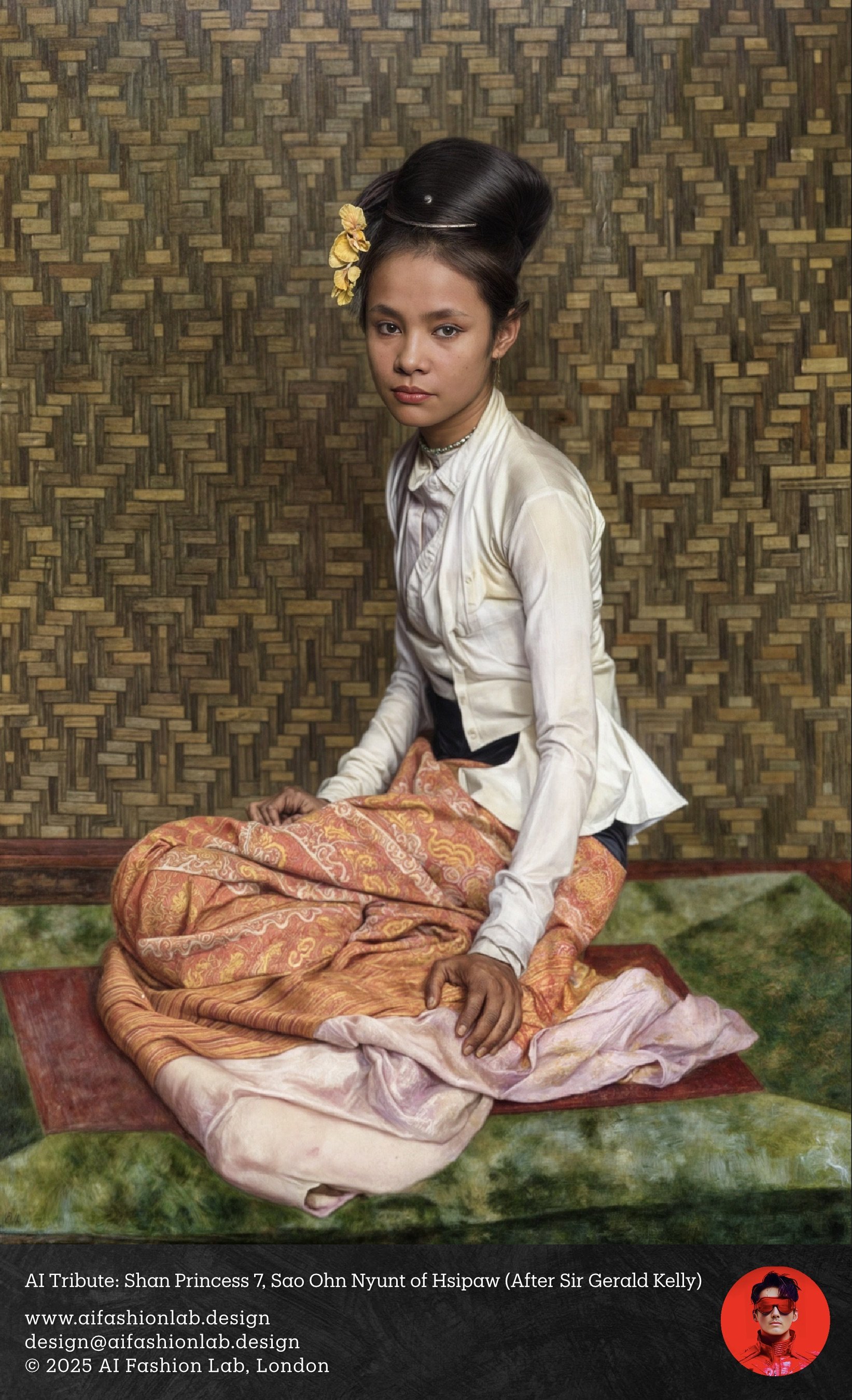Sir Gerald Festus Kelly and the Legacy of Sao Ohn Nyunt: A Vision of Burma’s Lost Independence
This is an AI tribute to Sir Gerald Kelly’s famous painting Sao Ohn Nyunt of Hsipaw, Shan State of Burma from the 1930s. He painted eight iconic portraits of Sao Ohn Nyunt, imagining her in traditional Burmese attire. One particularly renowned painting depicts her seated on a green velvet cushion, dressed in an ivory silk blouse and golden htamein, her hair adorned with gardenia blossoms. This portrait earned her the title “Mona Lisa of Asia” and remains a timeless testament to her elegance.
Sir Gerald Festus Kelly and the Legacy of Sao Ohn Nyunt: A Vision of Burma’s Lost Independence
Sir Gerald Festus Kelly (1879–1972) found profound inspiration in Burma (Myanmar), a country that shaped much of his artistic career. In 1908, he journeyed to Burma and created early masterpieces capturing the nation’s vibrant culture through paintings of Burmese dancers and landscapes. Over two decades later, his encounter with Sao Ohn Nyunt (เจ้านางอ่องยุ้นท์) in London inspired a series of portraits that have since become cultural icons.
In 1931, Sao Ohn Nyunt, a princess of Shan State, accompanied her brother-in-law, Sao Ohn Kya (เสืออุ่งจ่า), Saopha of Hsipaw, and her sister, Mahadevi Sunanda (มหาเทวีสุนันทา), to London for the Round Table Conference at St. James’s Palace. The conference, held on 12 January 1932, sought to discuss Burma’s future governance as a federal state. At just 19 years old, Sao Ohn Nyunt’s beauty and grace captivated Sir Gerald, who requested her to sit as a model for a series of portraits.
Sir Gerald painted eight iconic portraits of Sao Ohn Nyunt, imagining her in traditional Burmese attire. One particularly renowned painting depicts her seated on a green velvet cushion, dressed in an ivory silk blouse and golden htamein, her hair adorned with gardenia blossoms. This portrait earned her the title “Mona Lisa of Asia” and remains a timeless testament to her elegance.
The Historical Context and the Panglong Agreement
Beyond their artistic merit, these portraits represent a pivotal era in Burma’s history. The Round Table Conference laid the groundwork for the Panglong Agreement (สัญญาปางหลวง) in 1947, a landmark treaty led by General Aung San (นายพลอองซาน). The agreement envisioned a unified Burma built on democracy, equality, and autonomy for ethnic regions like Shan State, granting them the right to self-governance and potential secession after 10 years of independence. However, General Aung San was tragically assassinated in 1947, just months before Burma gained independence in 1948, leaving these promises unfulfilled.
General Ne Win and the Abolition of the Saopha System
In 1962, General Ne Win (นายพลเนวิน) seized power in a coup, dismantling the democratic ideals envisioned by the Panglong Agreement. One of his most significant actions was the abolition of the Saopha (เจ้าฟ้า) system, which had governed the Shan States for centuries. This move dissolved the traditional leadership of Shan State, stripping the region of its autonomy and integrating it into the centralised Burmese government.
The abolition of the Saopha system marked the beginning of an era of upheaval. Many Saopha, including Sao Shwe Thaik (เจ้าฟ้าส่วยเต็ก), the first President of Burma and a key advocate of the Panglong Agreement, were arrested or executed. These events created widespread unrest in Shan State and other ethnic regions, fuelling decades of conflict and resistance movements. The centralisation of power undermined the federalist vision of the Panglong Agreement, leading to feelings of betrayal among ethnic minorities.
Sao Ohn Nyunt’s Legacy in a Fractured Burma
The upheaval following General Ne Win’s coup profoundly impacted the Shan aristocracy, including Sao Ohn Nyunt and her family. Forced into exile, she and her descendants eventually settled in Sydney, Australia. Her portraits by Sir Gerald, however, remain as enduring symbols of her grace and the lost promise of Shan State’s autonomy.
Through my AI-enhanced collection, these portraits have been revitalised, bringing new life to Sir Gerald’s masterpieces while honouring their historical context. The images reflect the intertwining stories of beauty, resilience, and a nation’s struggle for democracy and equality.
The “Mona Lisa of Asia” as a Symbol of Hope
Today, Sao Ohn Nyunt’s portraits are more than just artistic treasures—they are emblems of Burma’s unfulfilled dreams of unity and autonomy. Sir Gerald Festus Kelly’s work immortalises her elegance while reminding us of the upheaval that reshaped Burma and the unkept promises of the Panglong Agreement. These paintings serve as poignant reminders of a time when hope for a united, democratic Burma still seemed within reach.
เซอร์เจอรัลด์ เฟสตัส เคลลี่ และมรดกแห่งเจ้านางอ่องยุ้นท์: พิศภาพผ่านเอกราชที่สูญหายของพม่า
เซอร์เจอรัลด์ เฟสตัส เคลลี่ Sir Gerald Festus Kelly (พ.ศ. 2422–2515) พบแรงบันดาลใจในพม่า ดินแดนที่มีอิทธิพลสำคัญต่อเส้นทางศิลปะของเขา การเดินทางไปพม่าในปี พ.ศ. 2451 ได้นำไปสู่การสร้างสรรค์ผลงานศิลปะชิ้นแรก ๆ ที่ได้รับการยกย่อง เช่น ภาพช่างฟ้อนชาวพม่าและทิวทัศน์ธรรมชาติ ซึ่งสะท้อนถึงวัฒนธรรมที่สวยงามและมีชีวิตชีวา กว่าสองทศวรรษต่อมา การพบกับ เจ้านางอ่องยุ้นท์ (Sao Ohn Nyunt) ณ กรุงลอนดอน ได้สร้างแรงบันดาลใจให้เซอร์เจอรัลด์วาดภาพเหมือนชุดหนึ่งซึ่งยังคงเป็นที่เลื่องลือจนถึงทุกวันนี้
ในปี พ.ศ. 2474 เจ้านางอ่องยุ้นท์ เจ้าหญิงแห่งรัฐฉาน (Shan State) ได้ติดตามพระเทวัน เสืออุ่งจ่า (Sao Ohn Kya) เจ้าฟ้าแห่งสีป้อ (Saopha of Hsipaw) และ มหาเทวีสุนันทา (Mahadevi Sunanda) ไปประชุมโต๊ะกลม (Round Table Conference) ว่าด้วยการปกครองของพม่า ณ พระราชวังเซนต์เจมส์ (St. James’s Palace) ในวันที่ 12 มกราคม พ.ศ. 2475 การประชุมครั้งนี้เป็นจุดสำคัญในการหารืออนาคตของพม่าในฐานะสหพันธรัฐ ด้วยวัยเพียง 19 ปี ความงดงามและสง่างามของเจ้านางอ่องยุ้นท์สะดุดตาเซอร์เจอรัลด์จนเขาได้ขอให้เธอมาเป็นแบบวาดภาพเหมือน
เซอร์เจอรัลด์วาดภาพเหมือนเจ้านางอ่องยุ้นท์ทั้งหมด 8 ภาพ โดยจินตนาการให้เธอสวมชุดพื้นเมืองพม่า หนึ่งในภาพที่โดดเด่นที่สุดคือภาพที่เธอนั่งบนเบาะกำมะหยี่สีเขียว สวมเสื้อไหมเนื้อบางเบาสีนวล และนุ่งทะเมง (htamein) สีทอง พร้อมเกล้ามวยผมแซมด้วยดอกพุดซ้อน ภาพนี้ได้รับการยกย่องอย่างมากจนเธอได้รับสมญานามว่า “โมนาลิซ่าแห่งเอเชีย (Mona Lisa of Asia)”
บริบททางประวัติศาสตร์และสัญญาปางหลวง
ภาพเหมือนไม่ได้เป็นเพียงผลงานศิลปะที่งดงาม แต่ยังสะท้อนถึงช่วงเวลาสำคัญในประวัติศาสตร์ของพม่า การประชุมโต๊ะกลมในกรุงลอนดอนเป็นจุดเริ่มต้นของ สัญญาปางหลวง (Panglong Agreement) ในปี พ.ศ. 2490 นำโดย นายพลอองซาน (General Aung San) สัญญานี้ได้สร้างวิสัยทัศน์ให้พม่ากลายเป็นประเทศที่รวมกันด้วยหลักประชาธิปไตย ความเท่าเทียม และการปกครองตนเอง โดยให้สิทธิรัฐต่าง ๆ เช่น รัฐฉานสามารถปกครองตนเองหรือแยกตัวได้หลังจากได้รับเอกราชครบ 10 ปี แต่ความฝันนี้กลับพังทลายเมื่ออองซานถูกลอบสังหารในปีเดียวกัน ก่อนที่พม่าจะได้รับเอกราชในปี พ.ศ. 2491 ทำให้คำมั่นสัญญาที่มีต่อรัฐฉานไม่เคยเป็นจริง
นายพลเนวินและการล้มล้างระบบเจ้าฟ้า
ในปี พ.ศ. 2505 นายพลเนวิน (General Ne Win) ยึดอำนาจผ่านการรัฐประหาร ล้มล้างหลักการประชาธิปไตยที่วางไว้ในสัญญาปางหลวง หนึ่งในความเปลี่ยนแปลงสำคัญที่สุดคือการยกเลิกระบบเจ้าฟ้า (Saopha System) ซึ่งเคยเป็นรากฐานการปกครองของรัฐฉานมานานหลายศตวรรษ การล้มล้างระบบนี้ทำให้ผู้นำรัฐฉานสูญเสียอำนาจ และรวมรัฐฉานเข้าเป็นส่วนหนึ่งของรัฐบาลกลางในพม่าโดยสมบูรณ์
การล้มระบบเจ้าฟ้านำไปสู่ความวุ่นวายในรัฐฉาน เจ้าฟ้าหลายพระองค์รวมถึง เจ้าฟ้าส่วยเต็ก (Sao Shwe Thaik) ประธานาธิบดีคนแรกของพม่า ถูกจับกุมหรือประหารชีวิต เหตุการณ์นี้สร้างความไม่พอใจในหมู่ชนกลุ่มน้อย และจุดชนวนความขัดแย้งที่ยืดเยื้อมานานหลายทศวรรษ ความฝันแห่งความเท่าเทียมและการปกครองตนเองตามที่ระบุไว้ในสัญญาปางหลวง จึงกลายเป็นคำมั่นสัญญาที่ไม่ได้รับการเติมเต็ม
มรดกแห่งเจ้านางอ่องยุ้นท์
ความวุ่นวายหลังการรัฐประหารส่งผลกระทบต่อเจ้าฟ้าและราชวงศ์รัฐฉาน รวมถึงเจ้านางอ่องยุ้นท์ ซึ่งต้องลี้ภัยไปยังฟิจิ และต่อมาย้ายไปพำนักในนครซิดนีย์ ประเทศออสเตรเลีย ภาพเหมือนของเจ้านางที่วาดโดยเซอร์เจอรัลด์ยังคงเป็นตัวแทนแห่งความสง่างามของเธอ และสะท้อนถึงความฝันแห่งอิสรภาพที่สูญหายไปของรัฐฉาน
ผมได้ปรับภาพเหมือนเหล่านี้ด้วยเทคโนโลยี AI เพื่อให้มีชีวิตชีวาอีกครั้ง ภาพเหล่านี้ไม่เพียงเฉลิมฉลองความงามอันอมตะของเจ้านาง แต่ยังสะท้อนถึงประวัติศาสตร์ที่ลึกซึ้งและความหวังที่ยังรอการเติมเต็ม เป็นสะพานเชื่อมระหว่างอดีตและปัจจุบัน สะท้อนถึงศิลปะอันยอดเยี่ยมของเซอร์เจอรัลด์และเรื่องราวของการต่อสู้เพื่อเอกราช
“โมนาลิซ่าแห่งเอเชีย” ไม่ได้เป็นเพียงภาพแห่งความงาม แต่ยังเป็นสัญลักษณ์แห่งความหวัง ความเท่าเทียม และความฝันของชาวไทใหญ่ที่ยังคงสะท้อนก้องในประวัติศาสตร์ของพม่าจนถึงทุกวันนี้.
#aifashionlab #AI #aiartist #aiart #aifashion #aifashiondesign #aifashionstyling #aifashiondesigner #fashion #fashionhistory #historyoffashion #fashionstyling #fashionphotography #digitalfashion #digitalfashiondesign #digitalcostumedesign #digitaldesign #digitalaiart #promptography #promptographer #prompts #fashionpromptography

